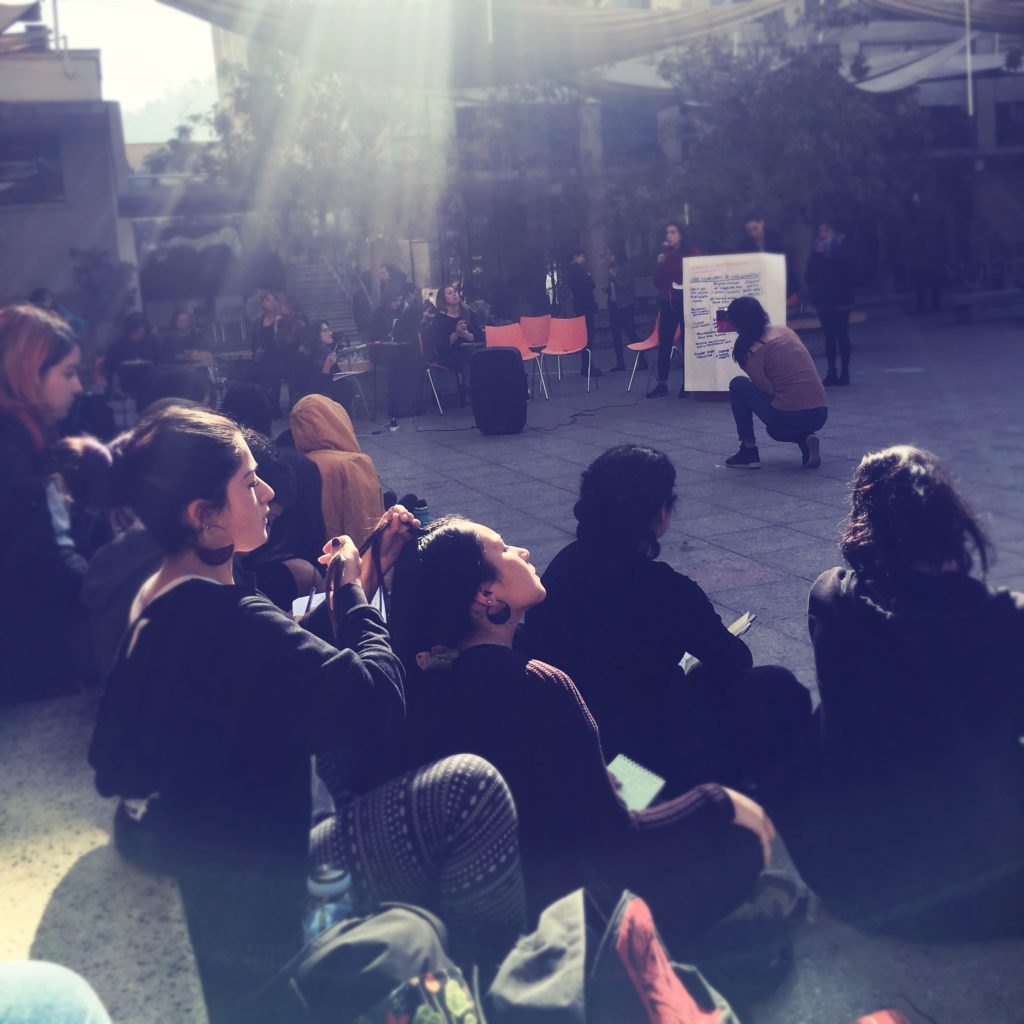The first of a two part series on looking at anti-capitalist feminism in South America and with a wealth of concepts and analysis that we can draw from in the US. Part two will include the article in pamphlet form for download and distribution. See below for a glossary of terms.
A Feminist Movement to End Capitalism: The Rise of Multisectoral Feminism in Chile
By Bree Busk
I. A Feminist Fall
It’s May of 2018 and as winter descends on Santiago, Chile, something new is growing. Graffiti blooms on every surface and the wheat-pasted posters accumulate on the walls like leaves on the ground. This is a familiar site to any Santiaguino; it marks the beginning of a new cycle of struggle for one of the major social movements. Student issues are always well-represented, but you are just as likely to spot a slogan in support of a Mapuche political prisoner or a poster advertising the latest day of action from the Coordinadora Nacional de Trabajadores y Trabajadoras No+AFP (the coalition organized against the corrupt Chilean pension system). However, if you step closer, you will notice that there has been a shift in theme, tone, and frequency: feminism is on the rise, and while there may be messages of sorority in abundance, they are sharpened by an intense anger directed squarely at those who have wielded patriarchal power against the women of this country.
NO es NO. YO TE CREO. PRACTICA LA VENGANZA.
NO is No. I believe you. Practice revenge.
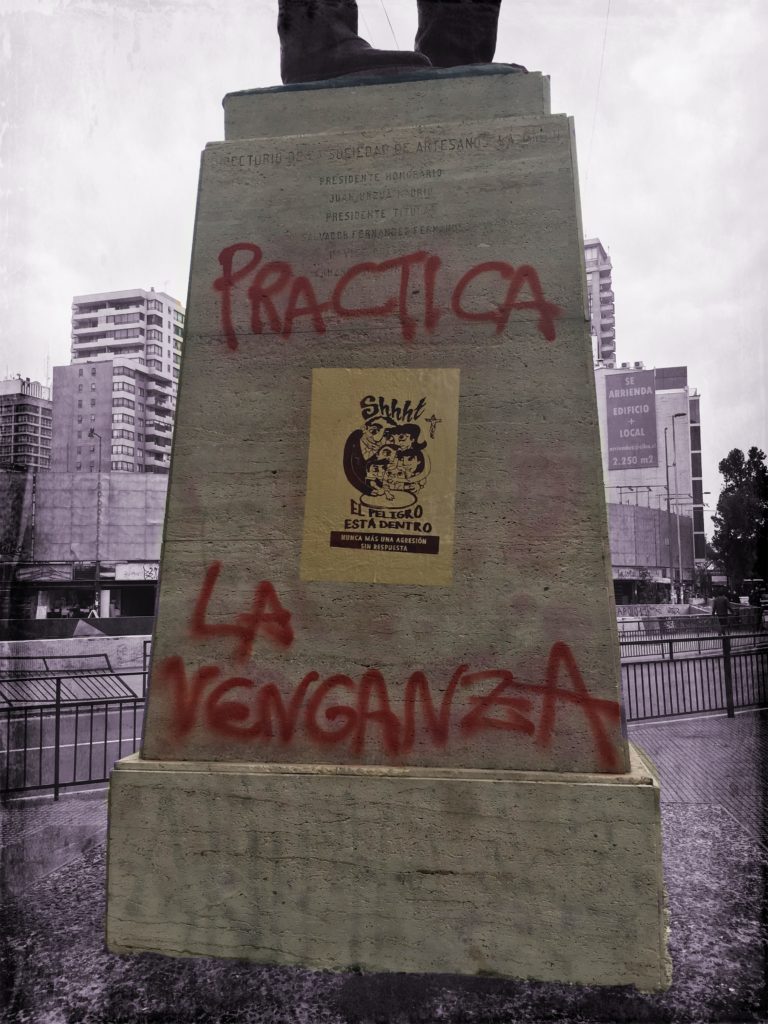
“Practica la Venganza” or “Practice Revenge!” Feminist graffiti spotted in downtown Santiago, May 2018
When I walk to work in the morning, I run into marches or the evidence of their recent passing. It’s not unusual to hear the echoes of distant drumming bouncing down the wide streets of Downtown. On social media, friends and acquaintances are making posts that have transitioned from cautious inquiries to joyous declarations: “Is the downtown campus of PUC occupied?” “Was UCEN taken over?” “Instituto Arcos on feminist strike!” Every week, I spot a new collection of feminist banners hung from the fences of Santiago’s most prominent institutions. All the universities are falling to the feminist strike and somehow, it only feels like the beginning.
II. The Water is Rising
When I arrived in Santiago in 2015, I was nothing short of starstruck by the Chilean feminist movement. As a North American accustomed to the moderate, anemic social movements of the US, I wasn’t prepared to witness the sheer numbers that would mobilize for almost any cause. I marvelled at the variety of organizations that filled the marches and snapped photos of every spray-painted slogan. I teared-up at the sight of fathers carrying their children on their shoulders during the demonstrations against gendered violence. I was sure that I was witnessing a strong, unified feminist movement for the first time in my life. It took me years to realize that I was viewing events through the lens of my political experience in the US: what I took for a well-developed expression of feminist power was, in reality, quite fragmented. Behind the scenes, conflicts were erupting in every sphere of the Left. Most organizations were struggling to change their sexist internal cultural (with differing degrees of success) while others were experimenting with new political forms and ideas. Many female radicals were resigning from traditional Leftist groups, often in favor of joining or starting feminist separatist projects. It was a time of great instability, but also a time of great political potential. The frustration and outrage felt by women, trans people, and queers were clearly intensifying, but the tension had yet to find release in a mass, popular movement. Everyone could feel something coming, but no one was sure which combination of events would finally crack the dam. Even now that the tsunami has hit, feminists are still struggling to analyze the moment in which they have found themselves. This process will doubtless be ongoing, but I believe that several contributing factors can be identified: the surge in global feminist visibility, the parallel ascensions of other social movements, and the pressure exerted on all Chileans and indigenous people through the continued application of the neoliberal policies instituted since the return of democracy.
First of all, Chileans are very aware of international political trends, especially those arising in other Spanish speaking countries. For that reason, you will see significant upsurges in Chilean feminist activity in response to global events. The #metoo movement in the US and its equivalent in Spain, #yotecreo (“I believe you”), aligned neatly with Chile’s history of funas, a tactic where people congregate around the homes of public figures in order to denounce and shame them for human rights violations or patriarchal violence. Known originally as an escrache, this tactic was developed in the mid-1990’s by HIJOS, an Argentinian organization consisting of the children of those “disappeared” during the dictatorship, and has since been adapted in many other countries. Funas or escraches are tools used when people believe there is no other recourse for justice, which is often the case with individuals who escaped criminal prosecution for the roles they played during their respective military dictatorships. Unfortunately, this also applies to abusers who, absent a community intervention, are often free to live their lives and perpetuate their violent behavior without experiencing any social or legal consequences.
In the current era, funas have gone digital and young women bravely post photos of their bruised faces on social media accompanied by explicit accounts of their abuse. Celebrities, musicians, and politicians have come under fire, but so have former romantic partners, friends, co-workers, and classmates. Young Chilean women are naming names and sharing screenshots. I can’t help but notice that the photos documenting intimate injuries are now frequently interspersed with selfies of smiling young men with damning captions: SEXIST. ABUSER. RAPIST. Another common slur is “macho de izquierda (sexist Leftist),” which is used to call out male Leftists who exhibit the same anti-feminist behavior as their right-wing counterparts. These funas serve not only to visibilize the daily struggles of young women, but to create social and political consequences for those who have done wrong. It is clear that perpetrators of gendered violence will no longer be given quarter: not at school, not at work, and certainly not in political spaces.
 “Like Che [Guevara] in the streets, but like Pinochet at home. Sound familiar?” Source: @RevueltaVioleta
“Like Che [Guevara] in the streets, but like Pinochet at home. Sound familiar?” Source: @RevueltaVioleta
A war cry against misogynistic violence, #NiUnaMenos (“not one [woman] more”) is a slogan that originated in Argentina and resonates strongly with Chilean feminists who are all too familiar with the prevalence of femicide. At home or abroad, it seems like every week brings new headlines about a woman being murdered out of violent jealousy or as a punishment for stepping beyond the traditional limitations imposed on her by society. For example, June 25th 2018 marked the two year anniversary of the death of Nicole Saavedra, a young lesbian from a rural, religious community who was kidnapped, tortured, and murdered by unknown assailants. Family members and the feminist network that has taken up the cause have stated that they feel the investigation of Nicole’s death was neglected due to the lack of importance placed on the lives of women, lesbians in particular. This is a recurring theme for Chilean feminists, who are met with resistance from both the government and media when they insist on the existence of femicide as a unique category that cannot be simply understood or combatted in the same way as other homicides.
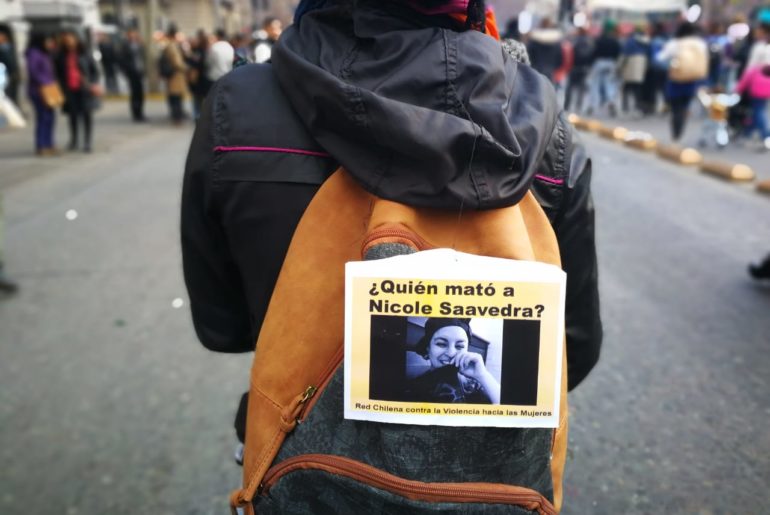
“Who killed Nicole Saavedra?” Photo: @ledezma_x
The persistent themes of domestic abuse, sexual violence, and femicide have been targeted by organizations such as the Red Chilena Contra la Violencia Hacia las Mujeres (a network dedicated to the eradication of violence against women and girls) and the Coordinadora #NiUnaMenos (the ‘Not One More’ Coordinator or NUM), which successfully instigated massive mobilizations throughout 2016 and into 2017. In May of 2018, the latter called for a “march against rape culture” in response to reports of the rape of a young woman by a gang of football fans and the horrific rape and murder of a 2-year-old girl at the hands of her uncle. The story of young Ambar’s death lit up the media not only due to its gruesome character, but because it served as a grim reminder that as of 2017, half of the reported victims of sexual violence in Chile are under 14 years old. Unfortunately, the news continues to deliver up dead women and girls and even the most terrible crimes are swiftly forgotten by the public. For many, the fight against apathy and resignation is a struggle in and of itself. In Chile, remembering is not only about personal reflection. Rather, it is political process that prevents the loss of collective knowledge and preserves the memory of martyrs. Contemporary feminists use the politicization of memory in the same way as the older generation who lived under the dictatorship: by honoring victims of femicide through art and political struggle.
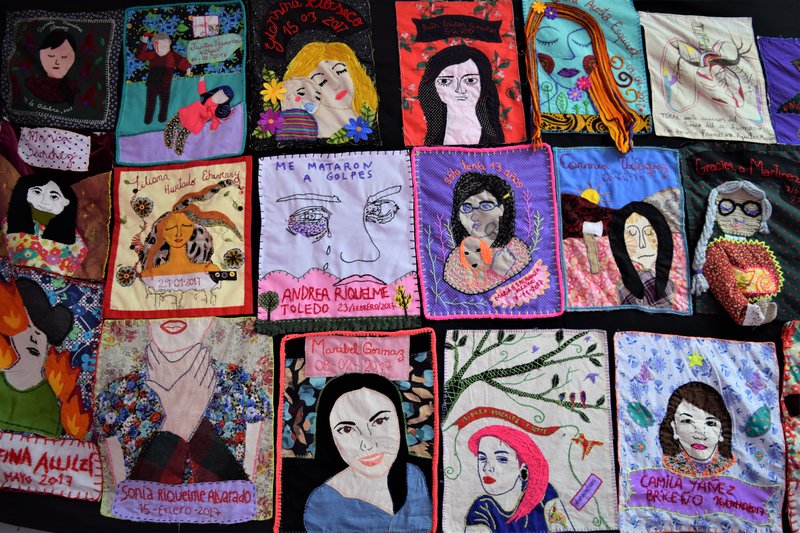
A patchwork memorial or Arpillera to the femicides that occurred in Chile in 2017. Arpilleras, now a symbol of resistance in Chile, used to be made by working-class women to depict life under the dictatorship. Text and Photo: Giulia Dessi
In late 2017, the struggle against femicide and gendered violence converged with the nascent immigrant rights movement with the death of Joane Florvil, a young Haitian woman who was accused of abandoning her infant daughter and was subsequently arrested and held in detention until her death 30 days later. As a recent migrant who didn’t speak Spanish, Joane was placed in a position of hyper-vulnerability, unable to explain her actions to the police or to defend herself against their accusations. Her crime was being a black migrant and mother in a country that is quickly learning to see her and others like her as an invading force. Joane was neither the first nor the last migrant woman to suffer or die from xenophobic discrimination, but the notoriety surrounding her case was so great that the image of her tear-streaked face as she was led away in handcuffs has come to stand as a symbol of the cruelty of the Chilean state towards the rapidly expanding migrant population — an antagonism exacerbated by anti-black racism and misogyny. Joane is remembered by her church, her community, and her partner, also a Haitian migrant, who gave a heartbreaking interview last May in which he famously said, “Chile taught me misery.” This tragedy continues to motivate those struggling to defend and improve conditions for migrants, as demonstrated by the recent founding of the Escuela Popular Joane Florvil, a popular education initiative designed to provide free Spanish languages classes to Haitian women. Joane’s memory is also honored through the Coordinadora 30 de Septiembre (the September 30th Coordinator), a pro-migrant and anti-racist organization named in commemoration of the day Joane died in the hospital without knowing justice or being reunited with her baby. With the passage of a new decree that singles out Haitians for a more restrictive immigration process, conditions will only become more precarious for this vulnerable group and feminism may come to be the lens through which these crises are understood and confronted.
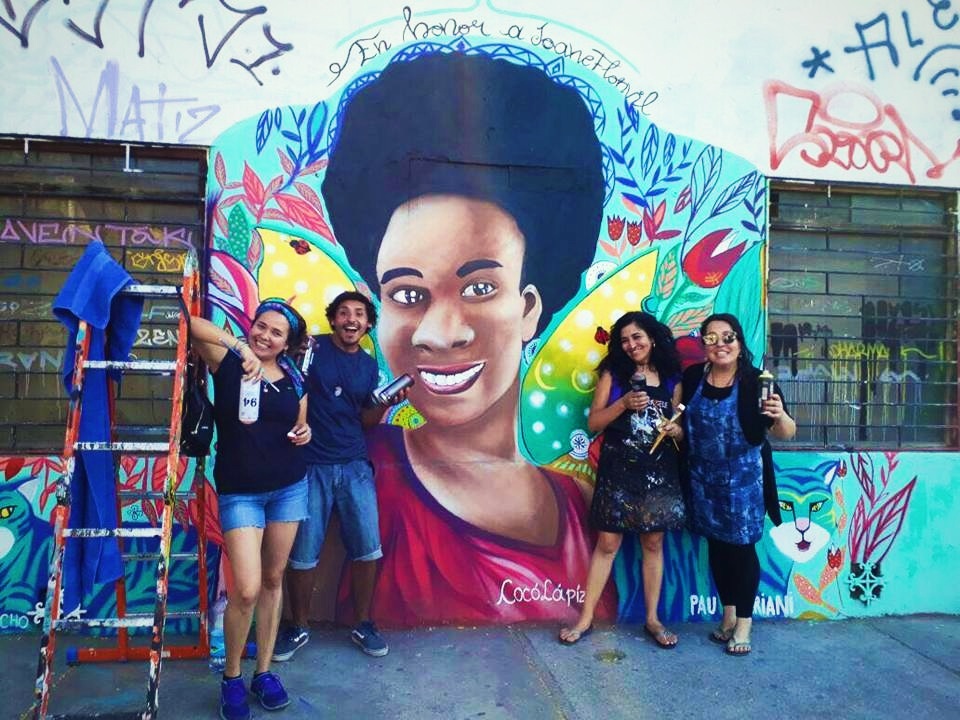
A mural “In honor of Joane Florvil” in the Bellavista neighborhood, Source: Civico
The themes of income disparity, reproductive labor, and precarity at home and in the workplace have been taken up most notably by the Coordinadora Nacional de Trabajadores y Trabajadoras No Más AFP (the National No More AFP Workers’ Coordinator or No+AFP), the massive coalition organized to reform and/or replace the corrupt pension system installed during the dictatorship. While not immediately recognizable as a feminist formation, this movement has been propelled forward by female trade unionists (among others) and hasn’t hesitated to highlight how women are uniquely disadvantaged under the current capitalist system due to gender-based income disparity and the uncompensated nature of work in the home (only 48.5% of women participate in the formal job market and on average earn 31.7% less than men). This movement is a national phenomenon, but it is also grounded in neighborhood and zonal formations where neighbors and co-workers meet to discuss and advance the struggle. Whereas the feminist wing of the student movement presents itself as young and transgressive (imagine: balaclavas, body-paint, and performance art), the women of No+AFP are less ostentatious in their mobilizations. However, this doesn’t mean they are any less aggressive in demanding their rights. In fact, many of them are seasoned militants active in neighborhood assemblies, labor unions, and political parties. The tension emerges when the feminism of the labor movement and poblaciones (shantytowns or working-class communities) intersects with the feminism of the student movement, which has largely, but not exclusively, been developed in the context of the most politicized high schools and universities. Certainly there is a vast gulf of experience between poor, rural Chileans and those who are able to attend the best universities in the capital city of Santiago, but it is the project of every social movement to identify the common threads capable of binding these groups together across and through their diverse experiences.
The neoliberal policies instituted under the dictatorship and expanded on by subsequent right-wing governments have touched the lives of all Chileans and indigenous people, and not with a soft hand. When seen from this perspective, the movements against privatized education, privatized social security, privatized healthcare, neoliberal labor reforms, and state violence (particularly against indigenous people) have everything to gain from recognizing and acting on their complementary objectives. This multisectoral approach is exemplified by the national organization Movimiento Salud para Todas y Todos (Healthcare for All Movement or MSpT), which unites healthcare workers, medical students, and patients to demand healthcare as a public right. They pursue this goal through many diverse campaigns, including support for Mapuche hunger strikers, improvement of patient conditions, public health education workshops, and the decriminalization and expansion of abortion rights. In the language of the Chilean Left, sectors are defined areas of struggle, such as labor, territorial (grounded in land and community), and student. Multisectoralism means having a cross-sectional analysis of these social movements and developing relationships of solidarity across these sectors, resulting in multisectoral support for specific demands.
The multisectoral movements of today reflect the experiments and advances of the past, as evidenced by the Revolución Pingüina (the high school student uprising in 2006), which opened the door for students to collectively interrogate the dynamics of oppression in other spheres of their lives. This heritage is clearly visible in contemporary political formations such as MSpT and the feminist organization La Alzada, which emerged from the student movement and went on to focus its political energy in the labor sector, where it offered anti-sexist trainings and supported the union struggles of both local and immigrant domestic workers. La Alzada was one of many university-based organizations empowered by the demand for an educación no sexista (non-sexist education), which was formulated in the peripheries of the student movement but went on to be a major force in shaping all struggles occurring within the educational sphere.
The student movement has proven itself to be remarkably flexible, capable of incubating new ideas and putting them into practice at a rate that the traditional Left can only watch with envy. One of these ideas was “sexual dissidence,” a radical answer to the neoliberal politics of inclusion and diversity. Popularized within the student movement by such groups as Colectivo Universitario de Disidencia Sexual (Sexual Dissidence University Collective or CUDS), sexual dissidence denotes “constant resistance to the prevailing sexual system, to its economic hegemony and its postcolonial logic” and rejects the idea of subversive identities (gay, lesbian, queer, trans, drag, etc.) in favor of subversive analysis and action. The result is an inclusive, combative politics that cannot be easily co-opted or institutionalized, no matter how many privileged individual participants are peeled away by token reforms. Since the theorization and practice of sexual dissidence developed in conjunction with the growth of student feminist activity, there is a significant movement tendency (concentrated in the capital city of Santiago) that has proved resistant to trans exclusive radical feminism or other regressive forms of feminist thought. This positive influence is visible in popular feminist assemblies and public demonstrations where trans and nonbinary feminists show up in far greater numbers than can be seen in the US and even hold leadership positions in their various organizations.
Contemporary Chilean feminism is refreshingly experimental and resilient, grounded in historical Leftist analysis, but open to integrating new theories and tactics as they emerge on the global level. By maintaining a class struggle orientation and infusing their analysis with lessons learned from Black and indigenous feminisms, this generation of feminists has created an opening for themselves to advance the struggle much farther than was previously considered possible. However, there are a number of forces that stand in ideological opposition to feminism and seek to sabotage the movement at every opportunity.

A young Felipe Antonio Kast pictured with Jaime Guzman, one of the most significant ideological leaders of the Pinochet regime. During his presidential campaign, Kast was quoted in an interview as saying “I was very close to Jaime Guzmán [. . .]. Jaime Guzman did a lot for the defense of human rights, as much in the laws he dictated as in how he dealt with people.” Source: The Clinic
III. Co-option, Fascism, and Threats From Within
The first threat comes from the Piñera administration, which is actively seeking to defuse and institutionalize the feminist movement by rolling out reforms under the banner of neoliberal gender equality. His proposed projects include ending the rule prohibiting women from remarrying until 270 days after the dissolution of their first marriage, instituting a project of “sala cuna universal” which entitles mothers with formal, salaried employment to childcare, introducing the right to breastfeed and the right to accompaniment for those with vulnerable pregnancies, and providing additional resources directed to the prevention of teen pregnancy, among others. This is the carrot dangled in front of political moderates, while the stick is represented by harsh new policies which seek to further criminalize both migrants (especially those with either Haiti or Colombia as countries of origin) and Mapuche (the indigenous people who inhabit central and southern Chile as well as parts of Argentina) who are locked in conflict with the Chilean state over issues of autonomy and land recovery.
Piñera’s neoliberal strategy can be understood as the “gentler” institutional approach when compared with the borderline fascist positions taken by contemporary far-right politicians such as congressman and failed presidential candidate José Antonio Kast, whose 2017 campaign drew support from conservative, libertarian, nationalist, pinochetista (supporter of the former Pinochet regime), and retired military groups, among others. He took traditional conservative stances against abortion and gay marriage, but stirred controversy by publicly declaring Chilean transgender actress Daniela Vega was “a man” and stating in an interview that he wouldn’t hesitate to shoot any criminal that entered his home. Together with his “law and order” approach towards illegal immigration and crime, these positions made him an inspirational figure to members of far-right groups organizing on the grassroots level. While it is presently unacceptable for a politician to openly identify as a pinochetista, it is no secret that many people in positions of governmental power were active supporters of the military government and benefited greatly from that participation. On the streets, however, fascists have no such reservations about making their violent agenda known and are increasingly bold in their mobilizations. The ascent of nationalist and ethno-suprematist movements in the US and Europe has given Chilean fascists a feeling of increased legitimacy and the threat of organized political violence against Black migrants and mobilized feminists is transitioning from empty posturing on social media to real violence on the streets.
Unfortunately, the final and possibly most potent threat comes from within the movement itself, which has been plagued by ideological splits and power struggles. After instigating massive mobilizations throughout 2016, the Coordinadora NiUnaMenos (NUM) effectively tore itself to pieces. The first split came as a result of the actions taken by Pan y Rosas (Bread and Roses), one of the larger member organizations, which acted in defense of a distant member of their partner political organization (Partido de Trabajadores Revolucionarios or Revolutionary Workers Party) accused of sexual harassment. After receiving considerable blowback for this stance, they attempted to use their numbers to force NUM to throw its support behind one of their besieged members, Bárbara Brito, who was serving as vice president of the Student Federation of the University of Chile (FECh). This blatant power-grab resulted in their expulsion from the coalition, but tensions remained high. Political factions had coalesced around two main tendencies: the feminists who promoted and were members of mixed gender political organizations and the anti-organizational feminists who rejected participation in all mixed organizations in addition to traditional Leftist groups or parties. The latter took a hardline position, going as far as accusing their opponents of being mere mouthpieces for the male members of their respective organizations. The atmosphere grew toxic and political debate devolved into bullying and personal attacks.
A second crisis rapidly emerged, stemming from a funa publicized through the NUM Facebook page. One of the rapists outed in this process threatened legal action and, instead of pursuing a collective response to this threat, a member of the anti-organizationalist faction chose to turn over the names of the page administrators to the police. This individual went on to make a deal with the rapist where NUM would publicly apologize for the funa and retract the charges against him. Before this series of events had finished playing out, the remaining pro-organizational feminists collectively determined that the coalition was no longer a safe or productive vehicle for their politics and chose to make their exit.
This rise and fall was mirrored throughout the Chilean Left, as the constant flood of funas and unsatisfactory disciplinary or transformational justices processes fragmented the smaller groups and caused deep rifts in the larger ones. For some, the disintegration of NUM must have been a cruel disappointment, especially after experiencing such a vibrant resurgence of feminist activity. However, the women who had discovered political affinity while navigating the myriad conflicts of NUM were far from despondent. On the contrary, the adversity they experienced forced them to hone their political analysis and articulate fresh alternatives to the positions and practices they opposed. These lessons were transmitted to the surviving mixed organizations and in this way, the metaphorical blood shed in this difficult period came to fertilize the soil from which the next stage of the movement would grow. As the dust finally began to settle at the close of 2017, some feminists continued to turn to groups of friends or separatist spaces to do their politics, while others began to grapple with the project of defining feminism as something transversal, multisectoral, and far more ambitious than what had come before.
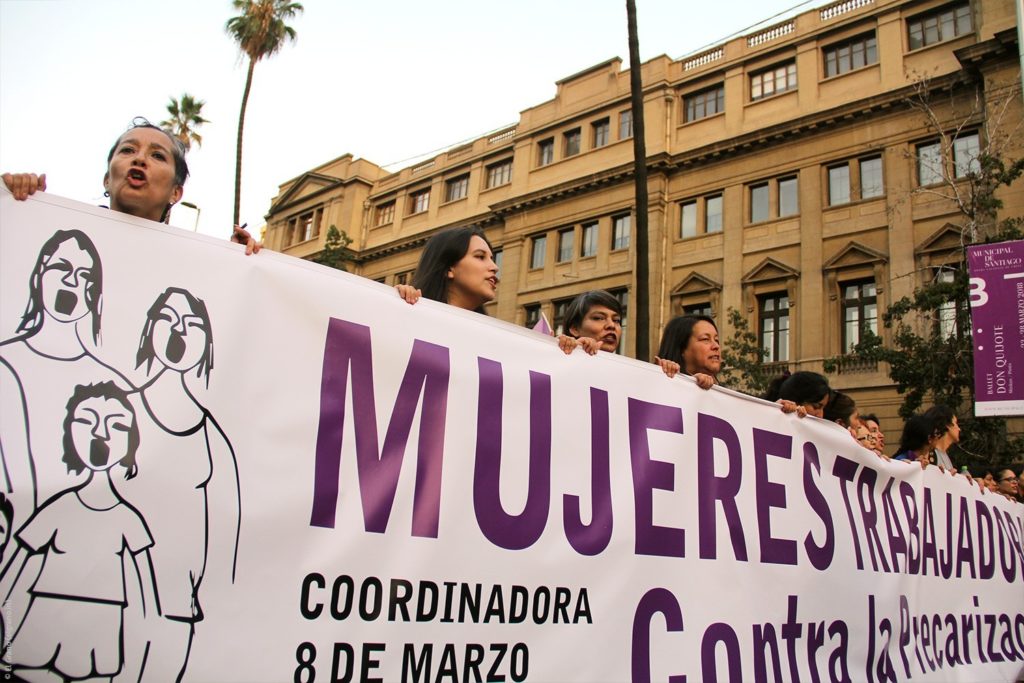
“Working Women Against the Precaritization of Life,” taken during the 2018 march for International Working Women’s Day. Source: El Grano
IV. Naming the Moment
Thus we arrive in January of 2018, with a mosaic of social movements, leftist parties, cultural collectives, neighborhood assemblies, and politicized individuals repositioning themselves to confront the new political landscape unfolding as the Piñera administration prepares to take power. Feminists are freshly outraged at the appointment of Isabel Plá (an anti-abortion right-wing extremist) to lead the Ministry of the Woman and Gender Equity and International Working Women’s Day is fast approaching. It is in this context that the Coordinadora 8 de Marzo (March 8th Coordinator or C8M) met to discuss the coyuntura (the combination of factors and circumstances that characterize a situation in a determined moment) of Chilean feminism.
C8M is an open coalition with a deceptively simple mission: to bring together a variety of social organizations, labor unions, and individual feminists to plan the annual march associated with its name. Every year, veteran participants and newcomers must coalesce around a common analysis of the state of feminist struggle and identify a theme capable of uniting a heterogeneous and conflictual movement. Recent years have highlighted the deadly effects of patriarchal violence with slogans such as “all the women against all the violence” and, of course, #NiUnaMenos. However, naming the moment in a way that speaks to women’s struggles in all their diversity is no small task.
As most modern feminists will admit, there is no universal experience of womanhood or gender-based oppression. Each individual stands at a unique intersection of identities and associated oppressions, a conclusion that has led some feminists to divide the movement into ever smaller organizations in order to insulate the hyper-oppressed from the moderately oppressed. When toxic dynamics produced by racism or transphobia divide the movement, a separatist approach is more than justified. That said, a potent movement is, by necessity, one that weaves together women of diverse backgrounds and experiences into a force capable of challenging patriarchal power on a systemic level. The feminists of C8M, many of whom were veterans of the conflicts of the #NiUnaMenos era, knew that isolationist separatism was a dead end for their political objectives. To build the movement they all felt was necessary, they needed to find the common thread that passed through the lives of all working-class women and gender dissidents: something to bring people together instead of tearing them apart. Towards this end, they adopted a transversal feminist approach.
Transversal politics is an organizational method designed to generate collective identity in non-hierarchical coalitions across and through the diverse positionalities of their members. In fact, these very differences are considered an asset, since it is only through analyzing a problem from multiple perspectives can “the truth” be ascertained. This method seeks to avoid the excessive universalism of the Left (which flattens differences, often in an ethnocentric and exclusionary manner) as well as the excessive relativism of contemporary identity politics (which are often essentialist and substitute individual identity for collective identity). Furthermore, transversal politics are not at odds with intersectionality (an analytic framework to understand the intersecting nature of systems of oppression and exploitation). Rather, they are an application of that theory in an inclusive coalition setting. In Black Feminist Thought: Knowledge, Consciousness, and the Politics of Empowerment, Patricia Hill Collins writes of how transversal politics show how we can remain rooted in the unique struggles of our own group while finding commonality with others experiencing a different facet of the same oppression. In order to build bonds of solidarity across our differences, “Empathy, not sympathy becomes the basis of coalition.” C8M would come to define two commonalities through which to channel this politicized empathy: the experience of individual and structural violence and the condition of working for others. The latter was interpreted in a broad way, acknowledging that women’s labor takes many forms, both salaried and informal, and must be visibilized in all places it occurs. This analysis opened the door for feminist struggle on all fronts, permeating all social movements positioned against capitalist exploitation and state oppression. It was possible, they posited, that feminism itself could become the commonality to unite and reinvigorate the Left as a whole.
What slogan could possibly speak to this common condition of labor exploitation and violence in all its myriad expressions? This year, C8M decided, feminists would mobilize “Against the Precaritization of Life” in solidarity with the call for an international women’s strike. This theme spoke to the effects of 30 years of neoliberal policies instituted in Chile after the return to democracy. While not always explicit in their targeting of women, the result of these policies was the further immiseration of a group already placed at a historical disadvantage. Whether a Mapuche on her ancestral territory, a student in the classroom, a worker on the job, a mother or care-taker maintaining her home and family, or an immigrant building a new life in a strange land, all women have felt the sting of intimate or structural violence and the systemic stripping of their autonomy and resources. C8M went on to identify four areas in which this slogan would enable the recognition of our interconnected struggles: racism and territory, salaried labor and social security, sexual and reproductive rights, and sexual dissidence. This year’s march would, by necessity, weave together the territorial organizations of the poblaciones, the zonal formations of NO+AFP, the typical female-dominated trade unions, the myriad student feminist organizations, immigrant organizations such as 30 de Septiembre, and many, many more, essentially representing a complete picture of Chilean social movements, all united through feminism.
This convergence of struggles was evident on March 8th 2018, when a never-ending stream of feminists of all ages, races, and genders overflowed the streets. I chose to follow the boisterous immigrant contingent and joined in the chants of “Mujeres migrantes, la lucha está delante! (Migrant women, the struggle lies ahead!)” and “Chilena o extranjera, la misma clase obrera! (Chilean or foreigner, the same working class!)” Although I didn’t have the words to describe it at the time, I could feel that something significant had shifted, that forces were coming into alignment. Months later, members of C8M would reflect that they knew discontent was rising in the universities as early as their first meeting in January. That said, few could have anticipated the feminist wave, better described as the feminist tsunami, that would sweep away schools and universities throughout the country just a few short weeks later.
Bree Busk is an American anarchist living and working in Santiago, Chile. She currently contributes to movements in both countries through art, writing, and providing the invisible, reproductive labor that organizations need to survive and flourish.
If you enjoyed this article we also recommend by Bree Busk “A Conservative Threat Offers New Opportunities for Working Class Feminism” and the critical anarchist feminist piece, “Breaking the Waves: Challenging the Liberal Tendency within Anarchist Feminism,” also authored by Busk together with Romina Akemi.

Students feminists direct their rage at La Moneda, the presidential palace. Source: Alma @alpezmar
Glossary of Terms
Administradoras de Fondos de Pensiones (AFPs): Private financial institutions responsible for the administration of the funds of individual pension saving accounts. This system was installed during the Pinochet dictatorship, under the advisement of the “Chicago Boys.”
Coordinadora: A coordinating organization, umbrella group, or coalition
Coyuntura: The combination of factors and circumstances that characterize a situation in a determined moment.
Educación no sexista: A demand for an educational environment free of institutionalized patriarchy, especially gender or sexuality-based discrimination. Since the initial emergence of this demand in 1981, it has been picked up again and again by the student movement, evolving and deepening throughout the process.
Funa: A tactic where people congregate around the homes of public figures in order to denounce and shame them for human rights violations or patriarchal violence.
Macho de izquierda: A slur used against male Leftists who exhibit the identical patriarchal behavior to their right-wing counterparts.
Militant: A disciplined member of a political party or group
Multisectoralism: A term used in the Chilean Left. The three main sectors are labor, territorial, and student movement. Multisectoralism means having a cross-sectoral analysis in offering solidarity support for demands and actions in other sectors. The Mapuche struggle is also considered another sector, but autonomous. The environment, feminism, and colonialism are not considered separate sectors but rather transversal issues that must be addressed in all sectors.
Población: Poblaciones are best understood as a shantytowns or poor, working-class neighborhoods. However, poblaciones around Santiago have a deeper political significance since they evolved as land takeovers by people who migrated from the countryside to the city. Some poblaciones have strong political and Leftist traditions, such as La Legua, Villa Francia, and Nueva Amanecer.
Sexual dissidence: Popularized within the student movement by such groups as Colectivo Universitario de Disidencia Sexual (Sexual Dissidence University Collective or CUDS), sexual dissidence denotes “constant resistance to the prevailing sexual system, to its economic hegemony and its postcolonial logic” and rejects the idea of subversive identities (gay, lesbian, queer, trans, drag, etc.) in favor of subversive analysis and action.

